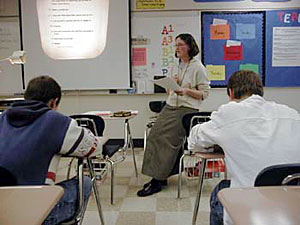Schools' testing burden grows under new federal law.
March 10, 2003
 |
| Students at Oak Grove Middle School in Bloomington recently gathered in a classroom to brush up on their test-taking skills. These after-school sessions are aimed at 8th graders at risk of failing the state Basic Skills Tests in reading and math. English teacher Kathleen West helped students prepare for the reading test. (MPR Photo/Tim Pugmire) |
St. Paul, Minn. — Students at Oak Grove Middle School in Bloomington recently gathered in a classroom to brush up on their test-taking skills. Tests are serious business in Minnesota schools. These after-school sessions are aimed at 8th graders at risk of failing the state Basic Skills Tests in reading and math. English teacher Kathleen West helped students prepare for the reading test.
"We do reading comprehension practice all year long, West said. "We don't practice for doing multiple choice tests all year long, but the skills that the students need to do well in the test are a big part of the eighth grade curriculum just naturally. As far as official test prep goes, we've been doing practice tests in class, but it only takes up a portion of our class time. It's not our major focus of the year."
Standardized statewide tests have been a requirement in Minnesota schools since 1996. The Basic Skills Tests measure minimum competency and are required for graduation. The Minnesota Comprehensive Assessments, or MCAs, are given in third and fifth grades and measure how well students and schools are meeting state academic standards. Minnesota's testing load will grow larger in the 2005-2006 school year. That's when the federal No Child Left Behind act requires annual reading and math tests in third through eighth grades. States must add science tests by 2007. The tests must be tied to state academic standards.
 | |||
"There are a tremendous number of issues to be resolved," said Jim Angermeyr, director of research and evaluation in the Bloomington school district. "We know very little, other than there will be a test like the MCAs every year between third grade and eighth grade, and something in high school."
Angermeyr says statewide testing is an important tool for comparing schools, measuring students against standards and checking the effectiveness of a district's curriculum. But he thinks testing every grade, every year is overkill.
"If you test a school in third grade and they perform at an average level, and you test them in fifth grade and they perform at an average level, one can assume that they would also score at the average level in fourth grade," Angermeyr said. "And you might argue that you don't need to test them again."
 | |||
Minnesota schools won't have a clear picture of the new tests until after state officials complete their planned rework of the state's academic standards. Gov. Tim Pawlenty is pushing to replace the current Profile of Learning standards with a back to basics approach, focusing on core subjects. His education commissioner, Cheri Pierson Yecke, says it will be an 18 month to two year process before the standards and corresponding tests are in place.
"The testing we're proposing, that will be criterion referenced tests tied to these standards, will be a very useful tool for teachers, a very useful tool for parents as well in determining exactly how their kids are performing," Yecke said.
The test scores will also be the lone measurement in a system for holding schools accountable for results. Test scores will be broken out by economic background, race and ethnicity, English proficiency and disability. Schools that fail to improve any group's performance will be placed on a list. Schools recieving federal Title I money will face increasingly stricter interventions. After two years on the list, schools must allow parents to send their children to higher performing schools. Re-staffing and state takeover are the ultimate sanctions.
The tests Commissioner Yecke praises as important "diagnostic tools" are criticized by other educators as "snapshots" in time that offer little information about a school. Ian Keith, president of the St. Paul Federation of Teachers, says tests do not measure everything that's going on in a school.
"The tests that we're going to be giving are math, reading and science," Keith said. "But we have other subjects that are equally important. We have social studies, the arts, a whole series of elective courses in high schools, and that's not measured on a test."
 | |||
Keith is among many educators who want annual tests to measure the growth individual students are making from year to year. They say just using a test score benchmark to measure the performance of students who are far behind their classmates, or who are just learning to speak English, does not account for any gains they make in a given school year. David Heistad, director of research, evaluation and assessment for Minneapolis public schools, says measuring gains is the only fair way to judge schools.
"Many of your students coming in new to the district, students who don't speak English and special education students, can't really be expected to be above a proficiency bar right away the first year," Heistad said. "But if you actually see how much progress students make toward that standard, and hold schools accountable, then you can really figure out which schools are doing the best job in terms of instruction."
A key state legislator agrees. Rep. Alice Seagren, R-Bloomington, chairwoman of the House K-12 Finance Committee, says she doesn't like the federal model for testing under No Child Left Behind. She says she supports instead a "value-added" testing system that would track individual students and groups of students year to year, showing their growth. Seagren says simply comparing this year's third graders to last year's third graders won't work.
"You may have a really outstanding group one year, and then the next year you have a group that maybe isn't doing so well," Seagren said. "So, then all of a sudden you've got these ups and downs in what appears to be a school district doing well one year and then all of a sudden they're falling apart. Well that's not true. It's the makeup of the students."
Seagren and other lawmakers must push ahead with the federal testing requirements with extremely tight state resources. State education officials say the cost of developing their current regimen of statewide testing, including the Basic Skills Tests and MCAs, has totaled $8.6 million. They could also develop the new tests from scratch or buy off the shelf national tests. Commissioner Yecke recently told members of Seagren's committee that the total cost of adding the new tests won't be known until new state academic standards are completed.
"You know, you can build a Cadillac of a test, or you can build a sound, sturdy Ford of a test," Yecke said. "It depends on where you want to be in the spectrum of testing." Yecke says Minnesota will receive $6.7 million in federal money under No Child Left Behind, which is earmarked for test development. She says her agency will also try to salvage as much as possible from the existing statewide tests to keep costs down.
|
News Headlines
|
Related Subjects
|

